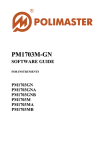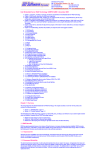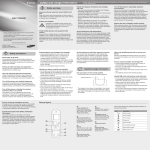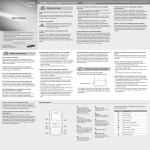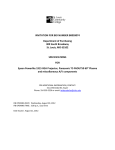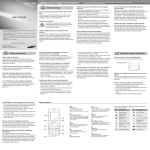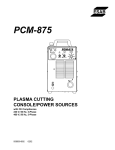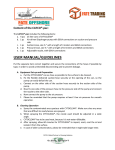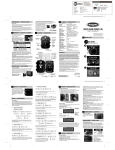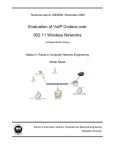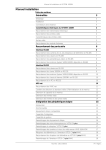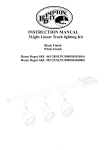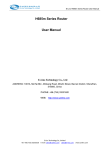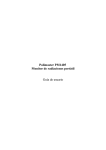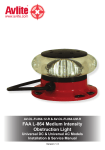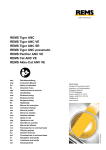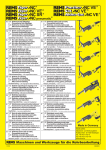Download PM-1703M Gamma Radiation Paging Device
Transcript
ALARMING RATEMETER PM 1703 M OPERATING MANUAL ТИГР 412114.004-01 РЭ ТИГР.412114.004-01 РЭ 2 ТИГР.412114.004-01 РЭ CONTENTS 1. APPLICATION and FEATURES ………………………………. .... 4 2. PRECAUTIONS ………………………………………………….. .... 5 3. GENERAL DESCRIPTION ..……………………………………..... 6 3.1 Introduction ………………………………………………….. ......... 6 3.2 Delivery kit ……………………………………………………......... 6 3.3 Overview of control buttons and display ........................................ 7 3.4 Overview of the operation modes .................................................... 8 4. SPECIFICATIONS ............................................................................ 11 5. OPERATING INSTRUCTIONS TO THE USER............................ 12 5.1 The unit operation check up ............................................................ 12 5.2 Searching gamma radiation sources............................................... 12 6. ADDITIONAL OPERATING INSTRUCTIONS TO THE ADVANCED USER....................................................................... 16 6.1 Parameters setting ............................................................................ 16 6.2 Communication with PC .................................................................. 17 7. DESIGN AND THEORY OF OPERATION .................................... 19 8. PERFORMANCE EVALUATION ................................................... 25 9. MAINTENANCE................................................................................ 27 10. TROUBLESHOOTING ................................................................... 28 11. STORAGE AND SHIPPING ........................................................... 29 12. WARRANTY .................................................................................... 30 13. ACCEPTANCE CERTIFICATE..................................................... 31 14. WARRANTY CERTIFICATE ........................................................ 32 ATTACHMENT Energy response of the PM1703M ....................................... 33 3 ТИГР.412114.004-01 РЭ 1 APPLICATION and FEATURES · The alarming ratemeter PM 1703M is designed to search, to detect and to locate gamma-emitting radioactive sources. It may be also used to measure dose rate of collimated Cs-137 gamma radiation. · The ratemeter operation history is stored in its non-volatile memory and may be transferred to a personal computer through an IR interface. · The instrument may be used both indoor and outdoor by various users whose professional duties involve detection and location of radiation sources. 3New pager- type design 3Meets the ITRAP requirements 3Easy to use 3Configuration via PC 3Dose rate indication 3Shock-resistant plastic case 3Reference to the background 3Light weight 4 ТИГР.412114.004-01 РЭ 2 PRECAUTIONS Before using this instrument, please read this operating manual carefully. Take special care to follow the safety instructions listed below. · The PM1703M is water resistant, but care should be taken to avoid an immersion into water. · As with any sensitive electronic instrument, the PM1703M should not be subjected to severe mechanical shock. · Clean the PM1703M with a soft, lightly wetted cloth. Do not use benzene or any other strong chemicals. · In searching for radiation sources your site regulations for work with radioactive materials and other radiation sources, as well as the Standards of radiation safety should be followed. i Some changes may be introduced in the instrument electrical scheme, construction, design and software that do not influence the specifications and, therefore, may be not specified in this manual. 5 ТИГР.412114.004-01 РЭ 3 GENERAL DESCRIPTION 3.1 Introduction The PM1703M is an easy-to-use instrument with two buttons only. To operate with PM1703M the user does not need to be an expert in nuclear physics or radiation protection. After been switched ON, the instrument woks automatically and alarms when finds a radiation source (gamma emitting isotopes). However, to make proper settings of the instrument parameters, to transmit data from the instrument memory to PC and, especially, to interpret the data obtained, the user should have some knowledge of radiation and a procedure of searching for radioactive sources. Accordingly, the present manuals has two sections: "Operating instructions to the user" and "Additional operating instructions to the advanced user". 3.2 Delivery kit Standard kit Type Item Alarming ratemeter PM 1703 M. Battery Quantity 412114.004 PANASONIC POWER LINE AA (LR6), or similar 412114.004 1 305641.031 1 Options available on order 426434.010 1 735231.027 1 Operating manual Package for shipping IR adapter (including CD with software and package) Carrying Case 1 1 6 ТИГР.412114.004-01 РЭ 3.3 Overview of control buttons and display BUTTONS The PM1703M has two control buttons that are located at the top panel of the instrument (Fig. 1). These buttons perform different functions depending on the mode used. In general, the button main functions are: 1 - MODE button is used: - to turn the unit ON; - to select the operation mode (background updating mode; dose rate mode; set mode); 2 - LIGHT button is used: - to turn the LCD backlight ON; - to initiate IR communication with PC. In the set mode the button functions are: 1- MODE button is used: - to select a set parameter (coefficient n, or turning ON/OFF the audio and/or vibration alarm devices); - to decrease the coefficient n value in steps of 0.1; 2- LIGHT button is used: - to activate changing the coefficient n; - to increase the coefficient n value in steps of 0.1; - to change the audio and vibration alarm devices ON or OFF. DISPLAY 4- the liquid crystal display (LCD) indicates: - count rate value; - dose rate value; - coefficient n value; - messages "test", "CAL", "-OL-", "ON", "OFF"; 5 - the analog scale of 19 segments indicates: 7 ТИГР.412114.004-01 РЭ - time left until self-tests are completed; a number of segments decreases until they completely disappear; - time left until the background updating is completed; a number of segments increases until the scale is completely filled; - relative value of the count rate excess over the calculated threshold in the case of alarm. 6 - battery discharge warning sign is indicated when the battery voltage drops below 1.1 V; 7 - RADIATION sign; it is indicated when the instrument alarms. 8 – coefficient of variation in percent; 9 - unit of measurement: “S -1“ (counts per second, cps), in the search mode; “µSv/h”, in the dose rate mode. 3.4 Overview of the operation modes The PM1703M operates in the following modes: self-test mode; background updating mode; search mode; dose rate mode; set mode; PC communication mode. · The instrument will go into the self-test mode immediately after it is turned ON, and the LCD displays "test". Time left until the self-test completion is indicated in the relative units on the analog scale with a number of segments decreasing. · After the self-tests are completed the audio and/or vibration alarms are activated for approximately 1 second, the instrument will automatically go into the background updating mode and the LCD will display "CAL" (calibration). In this mode the instrument measures the background and calculates the threshold. A time since the background updating began is indicated in the relative units on the analog scale with a number of segments increasing. The user may update the background value whenever it is necessary. Press and fix the MODE button for approx. 2-3 seconds. The LCD will display "CAL", and the background updating will restart. 8 ТИГР.412114.004-01 РЭ · When the background accumulation and necessary calculations (including threshold) are completed the PM1703M will automatically go into the search mode. In this mode the instrument automatically compares the current pulse count to the threshold and alarms when the threshold value is exceeded. In the search mode the LCD displays the current average count rate in counts per second. · While the PM1703M is in this mode, the user may search, detect and locate the radioactive sources. To evaluate the intensity of a radiation source (or background) press and release the MODE button and the instrument goes to the dose rate mode. The LCD will display dose rate in mS/h. The unit may be switched between the search and dose rate modes at any time by pressing and releasing the MODE button. · The PM1703M goes into the set mode by pressing and fixing the MODE button for more than 4 seconds. While in the set mode the user may check the preset value of the coefficient n, or set the new value and may also check the current status (ON or OFF) of the audio and vibration alarm devices, or to change it. i The set and/or dose rate modes may be disabled using an application program installed in your personal computer. · The PM1703M may be switched to the PC communication mode by pressing the LIGHT button (see section 2.3). While in this mode it is possible to make the necessary configuration of your PM1703M and to transfer the history of the unit operation stored in its non-volatile memory to PC. For more details please refer to the section "Additional operating instructions to the advanced user". The PM1703M is equipped with an automatic low battery detection circuit. If the voltage drops below 1.1 V, the battery discharge warning sign will be displayed in the LCD lower left corner. In this case the battery needs to be replaced (see section "Battery replacement"). The detector block operation is also checked. If the count rate is higher than the factory preset high limit, the LCD will display "-OL-" (OverLoad). To turn the instrument ON press the MODE button. To turn the unit OFF press the LIGHT button. While the backlight is ON, press and fix the MODE button until the LCD displays "OFF". 9 ТИГР.412114.004-01 РЭ 1 – MODE button 2 – LIGHT button 3 – window of IR- transceiver 4 – liquid crystal display (LCD) 5 – analog scale 6 – battery discharge warning symbol 7 – RADIATION symbol 8 – variation coefficient (%) 9 – unit of measurement 10 – lid of battery compartment 11 – battery 12 – outlet of audio alarm device Fig.1. The alarming ratemeter PM 1703M. General view 10 ТИГР.412114.004-01 РЭ 4 SPECIFICATIONS Type of detector Sensitivity (at Cs-137), appr. Detection of sources Energy range Measurement range of dose equivalent rate (at collimated Cs-137 radiation) Indication range Accuracy of dose rate measurements (at collimated Cs-137 radiation ) Measurement time Count time (by default) : - in the background mode - in the search mode Range of coefficient n (used to calculate threshold) Alarm types Power requirements Battery lifetime Communication with PC Number of readings stored in non-volatile memory Environmental: temperature range humidity Water tightness Drop test Dimensions (without clip) Weight (including the battery) CsI(Tl) scintillator 100 cps/(µSv/h) Meets the ITRAP requirements * 0.06 – 3.0 MeV 0.1 – 50 µSv/h 0.01 – 70 µSv/h ± 30 % 0.25 s 36 s 2s from 1 to 9.9 (step 0.1) audio tone and/or vibration one PANASONIC POWER LINE AA (LR6) battery ** 800 hours through IR interface. 900 -30 0C to +50 0C up to 95% at 35 0C IP65 0.7 m on concrete surface 87*72*35 mm 180 g * more details about the ITRAP program are available in the ARCS web site at the address http://www.arcs.ac.at/G or in the POLIMASTER web site at the address http://www.polimaster.com/en/support/docs ** another non rechargeable battery or a rechargeable battery may be used (AA size, 1.11.6V). However, battery lifetime and/or range of operating temperatures may differ from the stated above. 11 ТИГР.412114.004-01 РЭ 5 OPERATING INSTRUCTIONS TO THE USER 5.1 The unit operation check up Turn the PM1703M ON by pressing and realizing the MODE button. If the PM1703M is operative and the battery voltage is normal, the unit will go through a series of self-tests with all segments, signs and indicators displayed on the LCD. Then the LCD will display "test" and the analog scale with a number of segments decreasing in time. After the self-tests are completed the alarm will be activated and the unit will go into the background updating mode. The LCD will display "CAL." and the analog scale with a number of segments increasing in time. After the analysis of the gamma radiation background has been completed, the LCD will display for one second a value of the count rate, and the unit will go into the search mode. The PM1703M is ready for operation. If the battery voltage drops below 1.1 V, the LCD will indicate the battery discharge warning sign. The battery needs to be replaced! (see section "Maintenance"). 5.2 Searching for gamma radiation sources Refer to you site regulations and Operating Procedures prior to search operation. The following may serve as a general guide. i The PM1703M is intended firstly for efficient searching, detection and location of gamma radiation sources. It is not energy compensated and so it has a high sensitivity at low energies (60-300 keV, see Appendix), which allows efficient detection of nuclear materials. i When the PM1703M operates at temperatures below -15 °C, the LCD normal operation can not be guaranteed. In this case the audio and/or vibration alarm devices only should be used to detect radiation sources. When the normal conditions with temperatures higher than -15 °C are restored, the LCD will resume its normal operation. The PM1703M is provided with a clip and may be fasten to the belt. The clip may be removed using a screwdriver (see Fig.2). A carrying case is also available as an option. 12 ТИГР.412114.004-01 РЭ Fig.2. The PM1703M with a removable clip. 13 ТИГР.412114.004-01 РЭ Detection of gamma sources When detecting gamma radiation sources the instrument should be held so that the audio alarm device is directed onto the scanned object. When detecting gamma radiation sources under conditions when the audible signals produced by the instrument are not heard (for example, are damped by noise) the vibration alarm device should be used. The efficiency of detecting gamma radiation sources is the higher, the closer is the unit to the scanned object (article, person, container, vehicle, etc) and the smaller is the velocity of its movement along the object. It should be remembered that both a sensitivity of the instrument and a rate of false alarms depend not only on the preset coefficient n (for more details see section "Theory of Operation"), but also on the background value, which the instrument stored while in the background updating mode. As the changes of the natural background level may be significant, it is recommended to perform the background updating just before inspection. Press and fix the MODE button when the unit is turned ON, and the unit will automatically perform the background updating according to its new level. It should be noted that false signals (sound or pulsation) are not regular and, therefore, may be easily distinguished from alarm signals produced by the existing gamma radiation source as far as their rate is constant or increases when the unit moves closer to a gamma radiation source. Locating gamma radiation sources When the gamma radiation source is detected by the PM1703M or a stationary system, the gamma radiation source is to be located. To locate the gamma radiation source the instrument should be held at a distance no more than 10 cm from the scanned object. The velocity of movement along the scanned object should not be more than 10 cm per second. As the PM1703M moves closer to a gamma radiation source, the rate at which the audio tone or pulsation repeat will increase. When the maximum rate is achieved a continuous audio alarm sounds, but the rate of pulsation (if the vibration alarm device is turned ON) will not change. In this case further locating of gamma radiation source is not possible without background updating. Press the MODE button trying to keep a distance to the scanned object unchanged. The unit will automatically perform the background updating and then the gamma radiation source locating may be continued. If necessary this 14 ТИГР.412114.004-01 РЭ procedure may be repeated several times until a gamma radiation source is located. Dose rate indication Press and release the MODE button to switch to the dose rate mode. The LCD will display a dose rate in µSv/h (at 137Cs) on the upper scale and a coefficient of variation (%) at 0.95 confidence level on the low scale. If during the device operation in the dose rate mode, a value of the dose rate exceeds approx. 70 µSv/h, the LCD will display “-OL-”. i While in the dose rate mode, the alarm signals are disabled. They are automatically enabled after returning to the search mode. i The PM1703M is calibrated at collimated 137Cs radiation only. Thus, its readings in the dose rate mode may differ from readings of energy compensated dosimeters; this is not considered to be due to the improper operation of the PM1703M. 15 ТИГР.412114.004-01 РЭ 6 ADDITIONAL OPERATING INSTRUCTIONS TO THE ADVANCED USER 6.1 Parameters setting The instrument is supplied with the preset parameters and the modes: · dose rate mode - enabled; · set mode - enabled; · coefficient n = 5; · audio alarm device - ON; · vibration alarm device - ON. Thus, the user may see dose rate values and change the coefficient n value and status of alarm devices using the buttons. However other settings may be changed using an application program only (see section "Communication with PC"). To change a coefficient n value, enter the set mode by pressing the MODE button and fixing it for more than 4 seconds. The LCD will display “CAL.” and then the preset value of the coefficient n. To activate changing the coefficient n value, press and release the LIGHT button for 3 more seconds. The preset coefficient n value will flashing indicating that this value may be changed. If the button 2 is not pressed for 3 seconds, the unit will automatically go into the background updating mode (LCD will display “CAL.”). While digits are flashing, a repeated pressing the MODE button will decrease the value of the coefficient n by 0.1 and a repeated pressing the LIGHT button will increase it by 0.1. Hold the buttons down to change the numbers rapidly. The unit will automatically go to the background updating mode in 6 seconds after the last pressing of any button. To change the current status (ON/OFF) of either audio, or vibration alarm device enter the set mode by pressing the MODE button and fixing it for more than 4 seconds. The LCD will display “CAL.” and then the preset value of the coefficient n. Press and release the MODE button again. The LCD will display “1-on”. The figure 1 indicates the audio alarm device, and “on” shows that the audio alarm device is ON. Press the LIGHT button to change the status of the audio alarm device (ON/OFF). Press and release the MODE button once again. The LCD will display “2-on”. The figure 2 indicates the vibration alarm device, and “on” shows that the vibration alarm device is ON. Press the LIGHT button to change the status of the vibration alarm device (ON/OFF). The unit will exit from this mode if the MODE button is pressed, or automatically if no button is pressed for 6 seconds. 16 ТИГР.412114.004-01 РЭ 6.2 Communication with PC In addition to parameters mentioned above, the PM1703M has the next factory settings by default: · password - 1; · data storage interval - 60 min; · count time in the background updating mode - 36 s; · count time in the search mode - 2 s; An application program should be used to configure your PM1703M according to your requirements and site regulations. An application program PM1703 M.EXE is supplied on the installation CD together with an IR adapter (available as an option). Minimum requirements to a computer and its software: PC 486, 66 MHz; 8 Mb RAM; Windows 95/98/2000 (small font); 2 Mb free on the hard disk and an adequate space available to install the database; 800X600 resolution of a monitor. Connect the cable of an IR adapter to a communication port of the personal computer. The PM1703M may be switched to this PC communication mode by pressing the LIGHT button. To load the application program run the program SETUP.EXE and follow the instructions. “User’s Manual for the program PM 1703 M-interface” describes how to run the application program. Using this application program it is possible: - to register the unit to the specific user; - to store the time when the unit was received and returned; - to read the information from the unit memory, including the history of its operation: number of the unit; time of its turning ON/OFF; current values of the count rate in the data storage intervals preset by the user; value of the coefficient n; count time in the search mode and in the background updating mode; time and readings of the unit when the threshold was exceeded; 17 ТИГР.412114.004-01 РЭ - to enter a password to open a menu of parameters; - to set the operation parameters of the instrument: · to check and correct if necessary the current time and date; · to turn ON or OFF the audio and/or vibration alarm device; · to set the data storage intervals in which the current count rate value is stored in the non-volatile memory of the unit; · to check the present, or to set the new values of the count time; · to enable/disable the set mode operation using the buttons; · to enable/disable the dose rate mode. 18 ТИГР.412114.004-01 РЭ 7 DESIGN AND THEORY OF OPERATION The block diagram of the PM1703M is shown in Fig. 3. The instrument consists of: - detector block; - processing block; - audio alarm device; - vibration alarm device. The detector block consists of: - a CsI(Tl) scintillator with a photodiode; - a plate of amplifier-shaper. The scintillator-photodiode assembly transforms gamma-quanta to electric pulses that come to the input of the amplifier-shaper. The amplifier-shaper converts electric signals coming from the photodiode output to quasi-Gauss pulses that come at the input of the processing block. The processing block consists of: -processor module; -non-volatile memory module; -LCD module; -control buttons; -IR transceiver; -power supply module. The processor module is based on a 16-bit RISC processor and performs: -testing of the instrument every time as it is turned ON; -mathematical processing of data obtained; -control over all the operation modes; -output of the data processing results to the LCD; -control over the operation of the audio and vibration alarm devices; -battery voltage control. A non-volatile-memory module is designed to store the PM1703M operation history that involves: -current values of the count rate in data storage intervals; -cases when the alarm threshold is exceeded; -cases of background updating; -time when the unit is turned ON/OFF. 19 ТИГР.412114.004-01 РЭ Detector block Audio alarm device Processing block Vibration alarm device Power supply module Fig. 3. Block diagram of the PM1703M 20 ТИГР.412114.004-01 РЭ The non-volatile memory of the unit stores the following parameters: -the number of an unit; -information about the audio or vibration alarm devices turning ON/OFF; -the preset value of the coefficient n; -the current time and date; -the preset successive intervals in that the current count rate values are stored in the non-volatile memory of the instrument; -count time in the background updating mode; -count time in the search mode. The LCD module is designed to display the information about the self-test, the unit operation modes and registered values. The LCD module also contains a control circuit of the luminescent backlight, which is turned ON/OFF under the control of the processor module and is done by the LIFHT button. The IR transceiver is designed to make possible an exchange of information of the PM1703M with PC. The power supply module is a built-in power source including a battery and voltage transformers and electronic switches that are controlled by the processor module and supply the necessary voltage to the instrument blocks. The audio alarm device is designed to produce audible sound in the self-test and search modes. In the search mode a rate at which audible tone repeats will increase when the unit comes nearer to a gamma radiation source. The vibration alarm device is designed to produce signals that the operator senses as vibrations inside the case of the unit when the self-test mode is completed, or when the alarm threshold is exceeded in the search mode. In the search mode a rate of pulsation will increase when the unit comes nearer to a gamma radiation source. It allows a secret search for gamma radiation sources and is good in situations when sound tones are damped by noise. The audio or vibration alarm devices can be turned ON/OFF using software in the PC communication mode or manually using the buttons if the set mode is enabled. The PM1703M operates in the following modes: · · · · self-test mode; search mode; background updating mode; dose rate mode; 21 · set mode; · PC communication mode. ТИГР.412114.004-01 РЭ Self-test mode The PM1703M will go into this mode immediately after it is turned ON, and the LCD will display the message "test". The following tests are performed: LCD test; detector block test; processor test; non-volatile memory test; alarm device test. The time left until the self-test completion is indicated in the relative units on the analog scale shown in decreasing a number of indicated segments. After the self-tests are completed, the audio or vibration alarms will be activated for approximately 1 second, and the unit will go into the background updating mode. Background updating mode The unit will automatically go into this mode when the self-test mode is completed and the LCD will display the message "CAL" (calibration). In the background updating mode the analysis of the gamma radiation background value is performed. The processor counts pulses coming from the detector block, and the analog scale indicates in the relative units the time since the beginning of the background updating mode shown in increasing a number of indicated segments. The scale completely filled with segments indicates that the background updating is completed. Later on when the operator makes the unit to update the background, the background count time will automatically decrease with increasing the background level. The processor calculates the average count rate N b during the background count time and the threshold value P: with P = Nb*Tc+n*s, (1) s = Ö Nb*Tc (2) where: Tc - count time in the search mode; s - meansquare deviation of the value calculated using the equation (2) 22 ТИГР.412114.004-01 РЭ for Poisson distribution of pulses; n - number of meansquare deviations (coefficient n). The coefficient n changes the threshold value according to equation (1). It is obvious that the lower is the coefficient n, the lower is the threshold value, the higher is the unit sensitivity in the search mode. However, in this case a probability of false alarms will increase. When the background accumulation is completed the unit will display for several seconds the average count rate (in counts per second) during the background accumulation, calculate and store in memory the value of quantities which are necessary for further operations and will automatically go into the search mode. To update the background value, press and fix (for more than 2 s) the MODE button. The LCD will display "CAL", and the background accumulation will restart. Search mode In the search mode the processor will count pulses coming from the detector block in 0.25 s periods and store in memory a sum of pulses for the count time T c. A number of pulses for the last (recent) period is added to the sum every 0.25 s and the oldest count is discarded. Therefore, a number of pulses N c stored in the processor memory is updated every 0.25 s. The current value of Nc is compared to the alarm threshold P every 0.25 s. If the current value of the pulse count exceeds the threshold value, i.e. N c>P, then the audio and/or vibration alarm will be produced and the LCD will display the radiation danger sign. The rate at which audio tone repeats will increase, when an excess of Nc over P becomes more important, i.e. when the ratemeter comes closer to a gamma radiation source. When the audio alarm device is turned ON, the audible signals are produced. When the vibration alarm device is turned ON, the mechanical vibration is produced (the device case vibrates). In the search mode the LCD will indicate the current average count rate in counts per second. Dose rate mode While in the dose rate mode the PM1703M indicates the dose equivalent rate (DER) of photon radiation H*(10) at 137Cs in collimated radiation. The LCD will display the dose rate value (DR) in µSv/h, which is calculated according to formula: 23 DR = Nc / (K x Tc) ТИГР.412114.004-01 РЭ (3), where Nc is the total number of pulses during count time; Tc - count time; K - detector sensitivity (is set by the manufacturer during its adjustment in the process of production or when the detector unit is changed). While indicating the dose rate, the value of the coefficient of variation in percent is displayed on the LCD low scale. Set mode While in the set mode the user may perform the following operations: - to check the preset value of the coefficient n (a number of meansquare deviations) or to set the new one; a range of the coefficient n settings is from 1 to 9.9 in a step of 0.1; - to check the current status of the audio and vibration alarm devices or to change it (to turn ON or OFF) if changing is enabled in the PC communication mode. The unit will go into this mode after the button 1 is pressed and fixed (for more than 4 s). The PC communication mode was described in the section "Additional operating instruction to the advanced user". 24 ТИГР.412114.004-01 РЭ 8 PERFORMANCE EVALUATION The evaluation of the instrument performance includes checking (at collimated Cs137 radiation): - the dose rate range and accuracy of dose rate measurements, - the instrument sensitivity. This evaluation is performed under the normal conditions stated below. Influenced quantity Temperature Atmospheric pressure Relative humidity Gamma radiation background i Range of values 20 0C (± 5 0C) 101.3 kPa (+5.5 kPa; -15.3 kPa) 60 % (+20 %;-30 %) no more than 20 µSv/h In process of evaluation your site regulations for work with radioactive materials and other radiation sources, as well as the Standards of radiation safety should be followed.• The dosimetric verification unit with the source of 137Cs is to be used for checking. The equipment should be verified and the source should be certified. 8.1 The checking-up of the dose rate range and accuracy of dose rate measurements Place the instrument into the dosimetric verification unit so that the instrument side with the audio alarm device is directed to a source and the conventional true value of the dose rate at the geometrical center of the detector H t = 0.8µSv/h, but do not irradiate the instrument. Turn the instrument ON, turn the audio and vibration alarm devices OFF (section 6.1). Press and release the MODE button to switch to the dose rate mode. When the value of a variation coefficient becomes less than 5%, read the three background values Hbi in (5-10) seconds. Calculate the average background value H b Hb = (Hb1 + Hb2 + Hb3) /3 Irradiate the instrument. When the value of a variation coefficient becomes less than 5%, read the three dose rate values in (5-10) seconds and calculate the average dose rate value Hav. Calculate the relative error of indication I = (Hav - Hb - Ht )x100% / Ht . 25 ТИГР.412114.004-01 РЭ Repeat the above procedures for the conventional true of the dose rate of 12.0 µSv/h and 40.0 µSv/h. The results of checking are considered to be satisfactory if the relative error of indication is in the range from -30 % to +30 %. 8.2 The check-up of the instrument sensitivity Turn the instrument ON, turn the audio and vibration alarm devices OFF (section 6.1). When the instrument is in the search mode and the value of a variation coefficient becomes less than 5%, read the three count rate values of the background (in cps) Nbi in (5-10) seconds. Calculate the average background value N b. Place the instrument into the dosimetric verification unit so that the instrument side with the audio alarm device is directed to a source and the conventional true value of the dose rate at the geometrical center of the detector H t = 0.8 µSv/h, and irradiate the instrument. When the value of a variation coefficient becomes less than 5%, read the three count rate values (in cps) in (5-10) seconds and calculate the average value N av. Calculate the instrument sensitivity S = (Nav - Nb)/ Ht . Repeat the above procedures for the conventional true of the dose rate of 3.0 µSv/h and 12.0 µSv/h. The results of checking are considered to be satisfactory if the sensitivity is no less than 75 cps / (µSv/h). Note. At a higher temperate the instrument sensitivity may be by 40 % less than the sensitivity at a normal conditions. 26 ТИГР.412114.004-01 РЭ 9 MAINTENANCE 9.1 Maintenance of the device involves preventive treatment, battery replacement and regular check up of the ratemeter operation (as described in the section 5.1). 9.2 The preventive treatment involves external examination of the device, dust removing and deactivation in the case of the radioactive contamination Deactivation of the case is done with a tissue impregnated with ethyl alcohol. 9.3 To replace a battery: · turn the unit OFF; · remove a lid 10 (Fig. 1) of the battery compartment using a screwdriver, or coin; · remove an exhausted battery and insert the new one into the compartment observing the polarity symbols (“+” of the battery should be faced inwards of the unit); · close the battery compartment with the lid. When the battery is replaced, the LCD will display all segments and the unit will go into the self-test mode (see section 5.1). 27 ТИГР.412114.004-01 РЭ 10 TROUBLESHOOTING Problem Possible cause In any mode the LCD 1 Detector block failure displays 00 2 Processing block failure In any mode the LCD 1 Detector block failure displays "-OL-" 2 Processing block failure 3 A gamma radiation source close to the unit The audio and/or 1. Alarming devices are vibration alarm devices turned OFF. are not operating 2. The device (devices ) are not operative The LCD displays the Exhausted battery battery discharge warning sign Solution Send the unit to the manufacturer 1, 2 - Send the unit to the manufacturer 3 - Remove the source 1. Turn the devices ON. 2. Send the unit to the manufacturer Replace the battery (section 9.3) 28 ТИГР.412114.004-01 РЭ 11 STORAGE AND SHIPPING 11.1 Shipping Ratemeters in package may be shipped by any kinds of transport at the air temperature from - 50 °C to +50 °C. Ratemeters in package should be fastened in a vehicle. They must be arranged and fastened in transport so as to ensure their stable position and to avoid possibility of shocks against each other and the walls of a vehicle as well. When carried by see, ratemeters in package should be placed in hermetic plastic bags with silicagel. When carried by air, the ratemeters in package should be placed in hermetic compartments. 11.2 Storage Ratemeters are to be stored in the manufacture’s package at the air temperature from -15 °C to +50 °C and humidity up to 95 % at a temperature of +35 °C. The storage time should not exceed the lifetime of the ratemeter, that is 8 years. Ratemeters without package are to be stored at the air temperature from 10 °C to 35°C and humidity of 80 % at a temperature of 25 °C. The storage place should be free of dust, vapors of strong chemicals that may cause corrosion. 29 ТИГР.412114.004-01 РЭ 12 WARRANTY The manufacturer warrants this ratemeter to meet specifications provided that the user observes the guidelines of the ratemeter operation, shipping and storage described in the operating manual. The warranty period is 18 months since the date of sale. The warranty storage period is 6 months since the date of the ratemeter acceptance by the quality control department officer. Warranty and after-warranty repairs are carried out by the manufacturer or by a company authorized by the manufacturer. Warranty does not cover ratemeters: - which warranty period is expired if the ratemeter was purchased by the user within the limits of the warranty storage period; - which were subjected to the user’s service (the evidence of opening the device); -with mechanical damages, if the requirements of operation and storage were not satisfied; - without an operating manual. The warranty period is prolonged for a period of warranty repair. Warranty does not cover batteries. The battery replacement is not considered as the warranty repair. 30 ТИГР.412114.004-01 РЭ 13 ACCEPTANCE CERTIFICATE The alarming ratemeter PM 1703 M type 412114.004 serial number ___________________ is manufactured to meet the requirements of State Standards and the design specifications and accepted for operation. Head of Quality Control Department stamp place _____________________ signature ________________ name “___ “________________ _____________ 31 ТИГР.412114.004-01 РЭ 14. WARRANTY CERTIFICATE The alarming ratemeter PM 1703 M type 412114.004 serial number ___________________ is manufactured “___” ____________ ______. Manufacturer POLIMASTER Ltd. OFFICE Production Department Telephone: (375 17) 217 70 80 Telephone: (375 17) 263 72 Fax: (375 17) 217 70 81 Tel/Fax: (375 17) 263 81 88 E-mail: [email protected] [email protected] Address: 112 M. Bogdanovich str., 51Staroborisovsky trakrt, Minsk, Minsk, 220040, Republic of Belarus 220141, Republic of Belarus•• Date of sale “___” ________ _____ Seller ______________ signature Seller stamp _________________ The warranty (after warranty) repair is made “___” ____________ ______ The warranty period is prolonged till “___” ____________ ______ Manufacturer’s officer ______________________ signature Manufacturer’s stamp 32 ТИГР.412114.004-01 РЭ ATTACHMENT Energy response of the PM1703M Sensitivity, (cps)/(uSv/h) 700 600 500 400 300 200 100 0 10 100 1000 10000 E, keV Typical energy response of the PM1703M 33

































